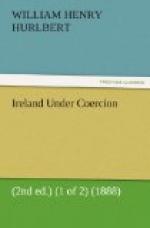This was the doctrine indorsed at the polls in New York in November 1886 by 68,000 voters. Nor can there be much doubt that it would have been indorsed by the few thousand more votes needed to defeat Mr. Hewitt, the actual Mayor of New York, and to put Mr. Henry George into the Chief Magistracy of the first city of the New World, had not its teachers and preachers been confronted by the quiet, cool, and determined prelate who met it as plainly as it was put. “Your letter,” said the Archbishop, “has brought the painful intelligence that you decline to go to Rome, and that you have taught, and will continue to teach, the injustice of private ownership of land, no matter by what laws of Church or State it may be sanctioned. In view of such declarations, to permit you to exercise the holy ministry would be manifestly wrong.”
In these few words of the Archbishop of New York, we have plainly affirmed in 1886 the principle underlying the Papal Decree of 1888 against the Plan of Campaign and Boycotting in Ireland. There is no question of parties or of politics in the one case or in the other. When Dr. M’Glynn talked about the private ownership of land in New York as “against natural justice,” he flung himself not only against the Eighth Commandment and the teachings of the Catholic Church, touching the rights of property, but against the constitutions of the State of New York and of the United States. That “private property shall not be taken for public uses without just compensation” is a fundamental provision of the Constitution of the United States, which is itself a part of the Constitution of every State of the Union; and the right of private ownership in land is defined and protected beyond doubt or cavil in New York under the State Constitution. An Act passed in 1830 provides and declares that all lands within the State “are allodial, so that, subject only to the liability to escheat, the entire and absolute property is vested in the owners according to the nature of their respective estates.”
By this Act “all feudal tenures of every description, with all their incidents,” were “abolished.” Most of the “feudal incidents” of the socage tenure had been previously abolished by an Act passed in 1787, under the first Constitution of the State, adopted at Kingston in 1777, a year after the Declaration of American Independence; and socage tenure by fixed and determinate service, not military or variable by the lord at his will, had been adopted long before by an Act of the first Assembly of the Province of New York held in 1691 under the first Royal Governor, after the reconquest of the province from Holland, and in the reign of William and Mary. This Act provided that all lands should “be held in free and common socage according to the tenure of East Greenwich in England.” It is an interesting circumstance that the right of private ownership in land, thus rooted in our history, should have been defended against a threatening revolutionary movement in New York by




